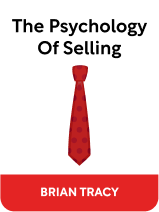

This article is an excerpt from the Shortform book guide to "The Psychology Of Selling" by Brian Tracy. Shortform has the world's best summaries and analyses of books you should be reading.
Like this article? Sign up for a free trial here .
Do you want to spice up your sales game? How can adding a little bit of creativity to your product pitch increase your chances of closing?
Most people think of creativity as something that applies to arts or literature. However, creativity is simply the process of creating something—and when you’re selling, you’re creating a business where there was none before. When you can increase your creativity, you can increase your success rate in closing sales and therefore increase your earnings.
Keep reading to learn how creative selling can enable you to find more customers and opportunities.
Creativity in Sales
When you engage in many of the practices of selling—looking for prospects, presenting solutions, answering questions and objections, closing the sale, and getting referrals—you’re accessing your creativity to connect with people.
- Prospecting: Finding more and better prospects through innovative ways will open up opportunities.
- Discovering buying motives: Figuring out how to get your customers to open up to you and reveal to you their underlying desires and fears takes creativity. The better you can figure them out, the better you can answer both their questions and their objections.
- Discovering additional benefits: When you can creatively figure out new applications for your product, you can open up markets that didn’t exist before.
Increase Your Creativity
Everyone is naturally creative on a daily basis—every time you think of new ways to avoid traffic, you’re using creativity. When selling, you use your creativity every time you convince someone of the value of your product. Creativity is a skill you can improve, and there are several things you can do to spark your creative thinking.
Educate Yourself
Before you can tap into the full potential of your creativity, you need as much information as possible about your product, your market, and your competition. Get specific and do a full analysis:
1. Study your product: Read all the information supplied by your company and search out more information online or by talking to people. Ask yourself:
- What are the five to 10 best features of your product?
- Why does a customer buy this product? What benefits is she usually after?
2. Study your customers: Become an expert in your market, in what your customers need and what challenges they face in their industries. Ask yourself:
- What qualities does your ideal customer have?
- What qualities do most of your existing customers have? (Apply the 80/20 Rule to your customers: Examine the 20 percent of your customers who make up 80 percent of your business. What do they have in common?)
- What changes are happening in your field at the moment? Who are your customers likely to be in one year? In five years? In 10 years?
- What other customers might benefit from your products or services that you haven’t reached yet?
3. Study your competitors: Find out what they’re selling and what benefits they’re emphasizing.
- Who are your primary and secondary competitors?
- Why does a customer buy this product from your company rather than a competitor’s?
- How does your product outperform your competitor’s?
Mindstorm
After you’ve fully educated yourself and thought through every aspect of your product and market, you can mindstorm to spark your creativity and inspire ideas. This method works by recognizing three things that stimulate creativity:
- Goals: When you have a clear goal, you’ll be more creative in finding ways to achieve it.
- Problems: When faced with pressing problems, you’ll be more resourceful in solving them.
- Questions: When you ask yourself focused and specific questions, you’ll come up with innovative answers.
Start by writing down your biggest goal or most challenging problem, in the form of a question. For example, “How can I increase my income over the next year?” The more specific you are, the better: “How can I increase my income from $60,000 to $80,000 over the next year?”
Then, write out 20 answers to that question. Write them in first person, present tense, and be specific. For example, instead of writing, “Meet more customers every week,” write, “I meet with four additional customers every week.”
From your 20 answers, choose one idea that you can implement immediately. Then, implement that idea without delay. Acting swiftly on an idea you generate inspires your brain to continue generating more ideas. You’ll find you have insights coming to you all day long about how to sell more effectively and accomplish more.
If you use this method every day, you will end up with hundreds of usable ideas every year that can propel you toward both your personal and career goals.
Use Your Creativity to Increase Your Sales
By increasing your creativity, you’ll find innovative ways to track down new business (prospecting) and to engage your customers (through strategic selling). We’ll explore both below.
Creativity in Prospecting
Getting creative in finding prospects might be the easiest way to increase your sales. If you can identify people who are not yet your customers but who might become customers, you can increase your sales dramatically.
Find Noncustomers
To increase your pool of prospects, look beyond the usual customer segments that you typically approach to find noncustomers—people who don’t use your product for some reason. Closely examine these noncustomers and ask yourself why they don’t buy your product. Ask yourself:
- Is your product not applicable to their needs? Or do they just not realize it’s applicable?
- What objection of theirs would you need to overcome to turn them into customers? How can you override the fear that is holding them back?
Once you’ve identified some ways in which you can appeal to potential customers, find ways to demonstrate to them that your product meets their specific needs.
Use Testimonials
A creative way to seek new customers is to use a testimonial letter—a letter from an existing customer vouching for your product, service, company, or you yourself.
People by nature value the opinions of others, but they are naturally suspicious of your opinions when you’re trying to sell them something. Consequently, when a prospect hears you say how wonderful your product is, she discounts your claim. However, when she hears the same thing from someone else, she believes it. In fact, 85 percent of all sales happen only after one person has heard a positive review from someone else. This is often called “word-of-mouth advertising.”
To get these letters of recommendation, simply ask existing happy customers for them. More often than not, they’ll be happy to recommend a product or service that they’re pleased with. If your customer is particularly busy, you can even offer to draft a letter for her to write up on her own letterhead. This sometimes makes the process easier for the customer, and they’re happy to comply.
You can get general letters of recommendation, and you can also get letters that counter specific objections. For example, if you often hear that your product is expensive, you can ask an existing customer to write a letter saying that even though the product costs more than some competing products, she has found it’s been worth the extra money because of the increased benefits she’s received from it.
Creativity in Strategic Selling
Improve your creative selling by thinking strategically. Four strategic selling techniques can improve your sales success. Use these techniques as a framework within which you can get creative:
- Specialization: When you specialize, you focus on servicing a narrow customer segment. You might specialize in a geographic region, a certain industry, a type of customer, or a particular benefit of your product or service. Being a specialist rather than a generalist can set you apart as an expert and can thus help you earn sales more easily. Get creative in your specialization: What customers might you look for who are currently underserved?
- Differentiation: When you differentiate, you define what makes your product or your company different from a competitor’s. This is called your competitive advantage—the reason a customer will buy from you and not from someone else. For example, a company might sell computers and software that are comparable to their competitors’, but if they have a reputation for providing excellent customer service to help a company run those computers, they have a competitive advantage and a unique selling proposition that their rivals don’t offer (this was IBM’s strategy in the 1980s). Get creative in defining your competitive advantage: How might you position a benefit so that it makes your product more special than another?
- Segmentation: Once you’ve established your area of specialization and what differentiates you from your competition, examine which segment of your customers can benefit most from your product. Imagine running an ad for your “ideal customer.” What would that ad say? Get creative: Who are some customers within your area of specialization that competitors might overlook?
- Concentration: Successful salespeople focus on the prospects who have the most potential. If you concentrate your efforts on the two or three customers who might earn you large sales, you’ll earn your income more efficiently than if you spread your time among many prospects who might only buy small amounts. This might be the difference between mediocre and great success. Get creative: How can you turn a valuable customer into an extremely valuable one?

———End of Preview———
Like what you just read? Read the rest of the world's best book summary and analysis of Brian Tracy's "The Psychology Of Selling" at Shortform .
Here's what you'll find in our full The Psychology Of Selling summary :
- How to dramatically increase your sales
- How to know what your customers are thinking
- Brian Tracy's 10 guidelines for success






